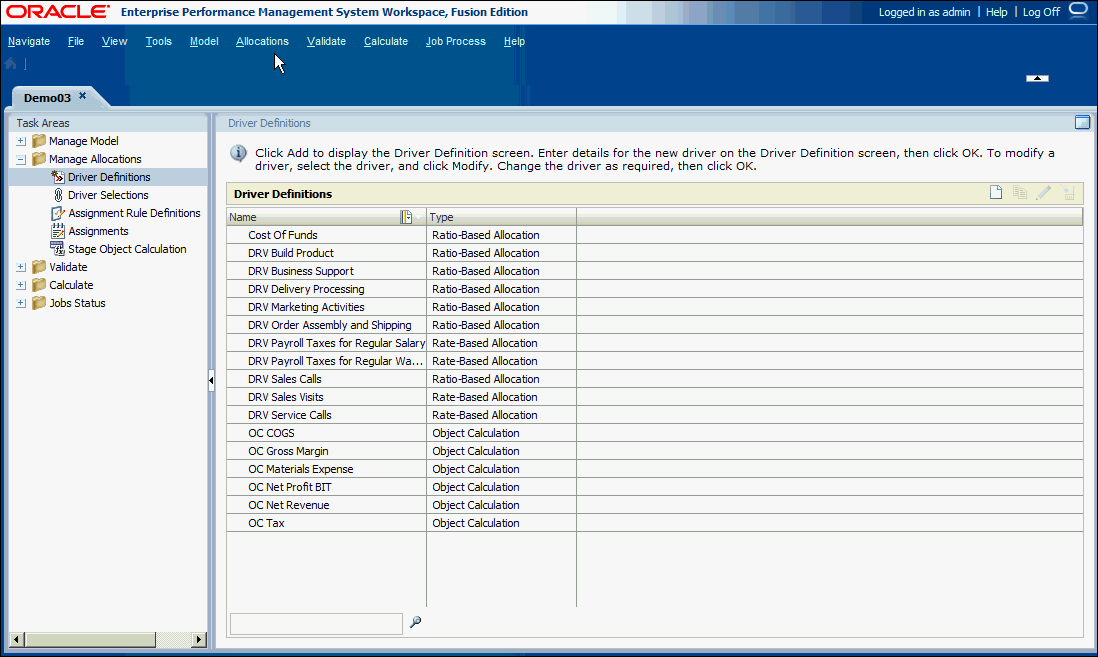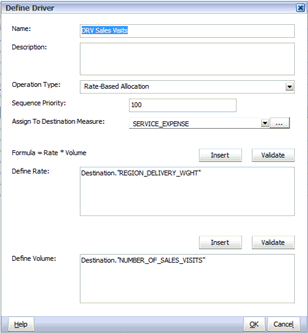Defining Rate-Based Drivers
To define rate-based drivers:
- From Oracle Hyperion Enterprise Performance Management Workspace, select Navigate, then Applications, then Profitability, and then select the application for which you want to create the driver.
- From Task Areas, select Manage Allocations, and then Driver Definitions.
The Driver Definitions window is displayed.

- In Driver Definitions, click Add New Driver
 .
.The Define Driver dialog box is displayed.

- For Operation Type, select Rate-Based Allocation.
- For Name, enter a unique name for the new driver.
Caution:
Do not use special or restricted characters in the driver name, such as /,+, or @ signs, because doing so may cause import operations to fail. See the Oracle Essbase Database Administrator's Guide to view the latest restrictions.
- Optional: In Description, enter a brief description of the purpose of the driver.
- In Sequence Priority, enter the calculation priority as a positive integer. By default, 100 is displayed. The highest priority is 1. For more information, see Driver Priority Sequence.
- Under Assign to Destination Member, click the Browse button
 to select the Destination measure to which the driver will write the allocated values, and then click OK.
to select the Destination measure to which the driver will write the allocated values, and then click OK.Note:
If Lookup measures is selected for Assign to Destination Measure, then appropriate validation error will appear on Drivers tab in Model Validation.
- Under Define Rate, enter the rate to be applied in the formula
(Rate * Volume).You can enter the actual rate, or you can create a formula using both the keyboard and the Insert button.
To use the Insert Selector:
- Click Insert to display the Insert selector for the available measures for the driver.
- From the drop-down list, select the stage within the model to which the measures apply: Source or Destination.
The list of Available Measures changes to reflect the choice made from the location list. For example, if Source is selected, only source measures are displayed.
- From the dimension members list, select the measure for the formula.
Use the Context Menu
 to filter or modify the display of members.
to filter or modify the display of members.
Note:
Filter and sort are available only when Grid View is selected.
- Click OK.
- Enter the formula, and then click Validate.
The SQL driver formula is validated, and a success message is displayed. Address errors before proceeding.
- Under Define Volume, enter the volume to be applied in the formula
(Rate * Volume).You may enter a specific volume, or you can create a formula using both the keyboard and the Insert button.
To use the Insert Selector:
- Click Insert to display the Insert selector for the available measures for the driver.
- From the list, select the stage within the model to which the measures apply: Source or Destination.
The list of Available Measures changes to reflect the choice made from the location drop-down list. For example, if Source is selected, only source measures are displayed.
- From the dimension members list, select the measure for the formula.
Use the Context Menu
 to filter or modify the display of members.
to filter or modify the display of members.
Note:
Filter and sort are available only when Grid View is selected.
- Click OK.
- Enter the formula, and then click Validate.
The SQL driver formula is validated, and a success message is displayed. Address any errors before proceeding.
- Click OK to save the new driver.
- Associate the driver with one or more dimension members. See Working with Detailed Profitability Drivers.